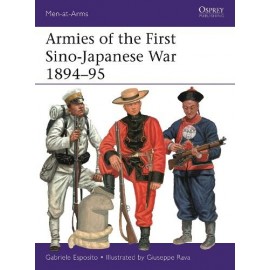Osprey First Sino-Japanese War 1894-95 Book Review

Book Review
Armies of the First Sino-Japanese War
1894-95
Author: Gabriele Esposito
Illustrator: Guiseppe Rava
Osprey Publishing
Men-at-Arms MAA 548 www.ospreypublishing.com
The Osprey
Men-at-Arms series give an excellent overview of the participants in units,
armies and conflicts and cover a lot of ground in 48 pages including 8 full
page illustrations. This is no exception. Fans of the movie “The Last Samurai”
featuring Tom Cruise might have wondered what happened next in Japan’s imperial
growth. This book chronicles the events that surrounded Japan’s first steps
towards becoming a colonial power that was to lead to Pearl Harbour and then ending
in Hiroshima.
The
introductory section covers the events in Korea preceding the war that lead to
Japan’s involvement and subsequent clash with the decaying Chinese Qing Dynasty
that lead to the conflict. The book includes a useful map showing the locations
of the key events and Japanese progress as well as a Chronology to give you a
guide to these.
The Military
Operations section covers both the naval and land battles starting from the
battle of Pungdo (naval battle on the 25th July 1894) and ending
with the Japanese occupation of Formosa (present day Taiwan) in 1895. The
descriptions of these battles are in outline as is customary with the MAA
series but should give a good overview and set the scene on the overall
campaign. Note the description of the Yalu River naval battle refers to the
Chinese flagship as the Matsushima – this was in fact the Dingyuan, correctly
the book ascribes the destruction of the flying bridge to Japanese gunfire
rather than a Chinese accident as found in some other sources. The author also
does not shy away from noting the comparatively rare atrocities attributed to
the Imperial Japanese Army such as at Port Arthur (Lushun) and during
pacification of the Formosan hinterland noting both of these were in reprisal
rather than the unprovoked type of incident they were to become notorious for
during the Pacific War.
For
wargamers and modellers the sections on the armies involved will be an
invaluable start into exploring further the period. Here not only are the
Japanese and Chinese are described but also the other protagonists, the Koreans
and Defenders of Formosa. Other books have looked at the Japanese and Chinese
armies involved in the Boxer uprising but here the information is specific to
this conflict and includes details of conscription, formations and order of
battle information including a basic Japanese order of battle chart on page 30.
These also include details of weapons including artillery as well as logistical
support troops. For both major armies there are useful period photos of the
participants giving further uniform details, the author carefully notes in the
captions where the period photos give a false image of colours. Similarly for
the Chinese, setting out the various types of army units employed and their
manifold weapons which ranged from archaic polearms and bows that would be at
home equally in the 15th century to a variety of modern European
designs including Krupps field guns and Nordenfeldt machine guns. Details are
included on the Korean forces and what is termed here the Defenders of Formosa
from the Chinese garrison to the exotic looking aboriginal forces divided here
into “civilised savages” and “wild savages”!
Of course
for many, the mainstay are the colour plate illustrations, often used as visual
references by modellers, wargamers and diorama builders. Here Guiseppe Rava,
known to many for his illustrations often seen on historical magazines, books
(including my own!) and even model soldier boxes. Here G. Rava has produced 8
illustrations of high quality covering all four types of army. His work just
gets better and better as can be seen on the elaborate brocade details on the
Imperial Guard Bannerman archer. Experienced model painters will want to step
up to the challenge here! The Koreans and Defenders of Formosa not often seen
illustrated get a page each of some inspiring warriors.
Rounding the
book off there is a Select Bibliography not to forget the other related MAA
series books such as Imperial Chinese Armies 1840-1911 (MAA 505) for those
intrigued enough to want to go further.
Highly
recommended for those with an interest in trying something different and
wanting an overview of this significant conflict.
John Kersey
Illustration copyright Osprey Publishing
Your shopping cart is empty!

